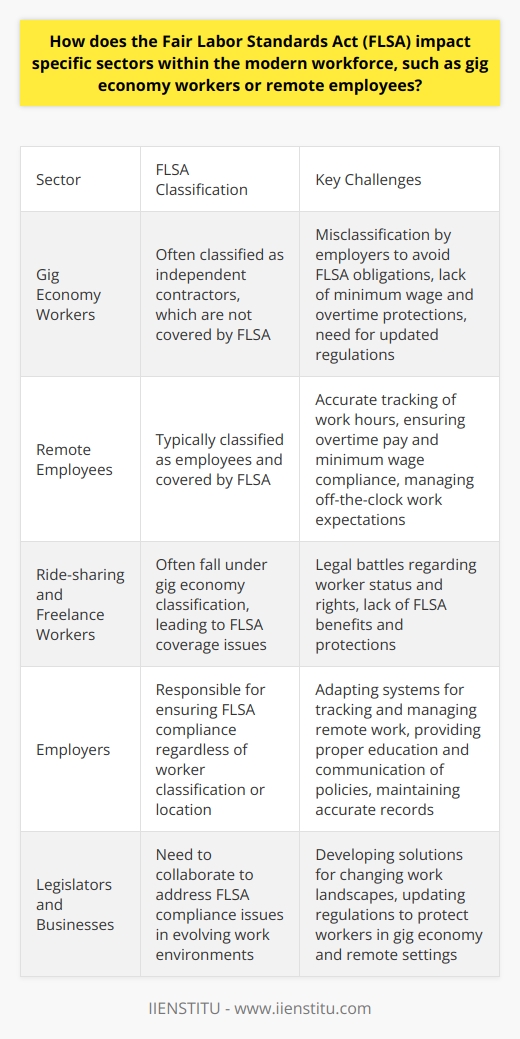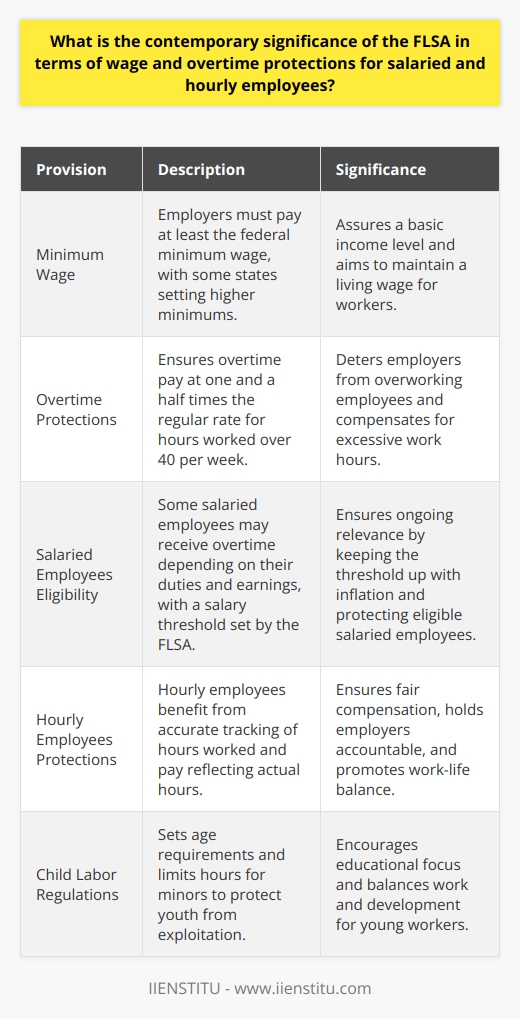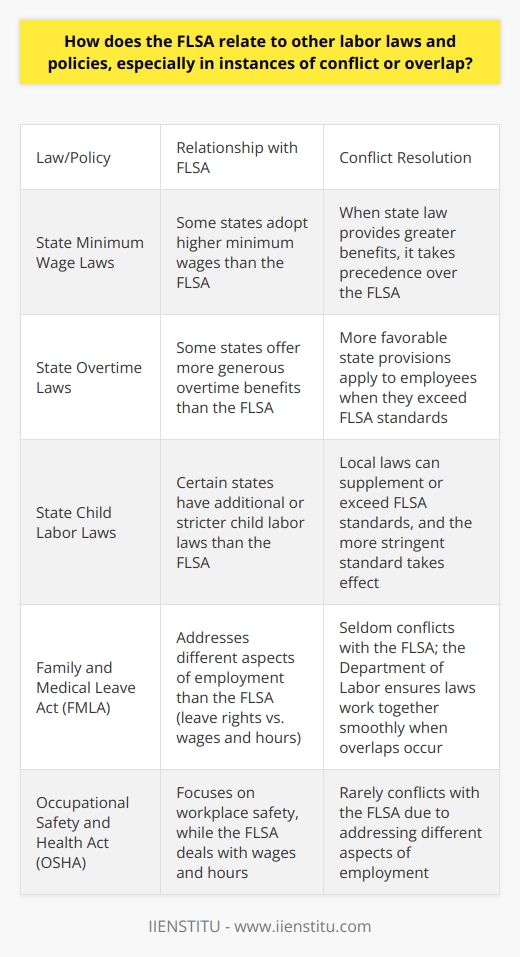
I still remember my first job, working in a small coffee shop just after graduating from college. The shifts were long, and the pay? Well, let’s just say it barely covered my rent. But one day, I overheard a conversation between my boss and a colleague about overtime pay, and something clicked. It wasn’t until I started digging into labor laws that I truly understood the Fair Labor Standards Act (FLSA) and how it impacted not only my job but the entire workforce. That moment sparked a journey for me—one where I became passionate about labor rights and employee protections.
The FLSA, though established in 1938, is still a cornerstone of labor law today. Its influence stretches far beyond those initial conversations I overheard, reaching into the lives of millions of workers, whether they know it or not. But understanding it, especially in today’s world of remote work and evolving workplace dynamics, is more critical than ever. Let me take you through an emotional and humanized exploration of the FLSA and why it matters.
Introduction to The Fair Labor Standards Act (FLSA)
I wish I had understood the FLSA better when I was younger. It’s the kind of law that quietly sits in the background, protecting workers in ways they may not even realize. The Fair Labor Standards Act (FLSA) was signed into law by President Franklin D. Roosevelt in 1938 as a response to the widespread exploitation of workers during the Great Depression. At its core, the FLSA sought to protect workers from unfair pay and overly demanding working conditions. And while this might sound like ancient history, the reality is that its implications are as alive today as they were in the early 20th century.
For modern employees and businesses, the FLSA is much more than just a law about wages—it is a safeguard that ensures fairness, decency, and respect for those who invest their time and effort into their jobs. Whether you’re a seasoned HR professional, a small business owner, or a new worker like I was years ago, the FLSA is something you’ll inevitably encounter in your professional life.
The History and Purpose of the Fair Labor Standards Act (FLSA)
Let’s take a quick walk down memory lane. Before the FLSA was passed, American workers were subjected to grueling hours with little pay and few protections. Imagine working 70-hour weeks without overtime, in dangerous conditions, and still struggling to make ends meet. For most people today, that’s unfathomable, but it was the harsh reality for many in the industrial era.
The Great Depression only exacerbated these problems, as companies cut corners to stay afloat, often at the expense of their workers. The FLSA wasn’t just a law; it was a beacon of hope for workers who desperately needed protection. It promised a fair minimum wage, limitations on working hours, and standards for child labor.
I’ve heard stories from my grandparents about how life was before these protections were put in place. My grandfather, who worked in a factory as a teenager, told me about the long shifts he endured just to help his family make ends meet. That was the world before the FLSA. In many ways, this law wasn’t just about labor—it was about dignity.
Key Components of the Fair Labor Standards Act
Fast forward to today, and the FLSA remains a pivotal piece of legislation that dictates how businesses operate concerning their workforce. It’s not just about protecting workers; it also sets the minimum standards for employers. Here are some of the key components that every worker and employer should be familiar with:
1. Federal Minimum Wage
One of the most recognizable aspects of the FLSA is the establishment of a federal minimum wage. It’s the baseline for what employers can pay their workers. However, one thing that often gets overlooked is that states can set their own minimum wage. In fact, many states have a higher minimum wage than the federal rate. This can cause confusion for both employers and employees alike.
I once worked for a company that operated in multiple states, and we constantly had to adjust our payroll to accommodate the different wage laws. It was a headache at times, but it highlighted the importance of staying compliant with both federal and state laws. Knowing your rights as an employee can make a huge difference in how you’re compensated.
Exceptions to Minimum Wage
However, not all workers are entitled to the same minimum wage. Employees who rely heavily on tips, for instance, may fall under a different set of rules. Tip-based workers often receive a lower hourly rate because it’s assumed they’ll make up the difference in tips. This can be a tricky area, and it’s where the importance of recordkeeping—another key part of the FLSA—comes into play.
2. Overtime Pay
Here’s where things can get particularly interesting, especially for workers who put in more than 40 hours a week. The FLSA mandates that employees who work beyond 40 hours must receive overtime pay, calculated at one and a half times their regular hourly rate. When I first heard about this, I was intrigued. Overtime was something I thought only happened in big corporate jobs, but it turned out I had been missing out on extra pay in my earlier roles.
When Is Overtime Applicable?
Overtime applies to non-exempt employees, meaning those who aren’t in managerial or certain professional roles. However, understanding if you're eligible for overtime isn’t always straightforward, and many workers might not even know they qualify.
Back when I was juggling multiple part-time jobs, I never thought to ask about overtime. Only later did I realize that one of my employers had technically been underpaying me because I wasn’t aware of my rights. It’s a lesson in knowing the rules—and in making sure you’re paid what you’re owed.
3. Child Labor Protections
Another critical aspect of the FLSA is its protection of minors. These rules are in place to ensure that young workers can still focus on their education and aren’t put in dangerous situations at work.
Age Restrictions
The FLSA sets clear age limitations on when and how minors can work. For instance, children under the age of 16 are typically restricted from working in hazardous jobs, and their hours are limited during school weeks.
Hazardous Occupations
I remember my first job at a fast-food restaurant, flipping burgers and cleaning tables. While that might not seem hazardous, the rules around child labor kept me out of more dangerous roles in the kitchen, such as operating heavy machinery. It’s these small but vital rules that make a difference in keeping young workers safe.
4. Recordkeeping Requirements
One of the unsung heroes of the FLSA is its emphasis on recordkeeping. Employers are required to maintain accurate records of hours worked and wages paid. This isn’t just bureaucratic red tape—these records form the foundation of a worker’s rights and ensure transparency.
Duration of Recordkeeping
Employers must keep records for at least three years, and they should be available for inspection by the Department of Labor if needed. This serves as a safeguard, ensuring that businesses stay compliant and that employees can verify their compensation.
Exemptions and Special Rules in FLSA
Of course, the FLSA doesn’t apply to everyone in the same way. There are several exemptions and special rules for specific industries and job roles. Understanding these nuances is critical for businesses, especially those operating in specialized sectors like agriculture or healthcare.
1. Exempt Employees
Some employees are exempt from overtime and minimum wage provisions. This usually includes executives, administrative workers, and certain professional roles. These exemptions are based on job duties and salary levels.
2. Special Rules for Certain Jobs
Industries like agriculture or schools often have unique requirements. For instance, workers in agriculture may have different overtime rules, and hospitals often operate under a different set of guidelines due to the nature of the work.
Ensuring Compliance and Understanding Rights
Compliance with the FLSA is not just a legal obligation—it’s about fairness and respect for workers. Both employers and employees must understand their roles and responsibilities under the Act.
Employer Responsibilities
As someone who has worked in HR, I can tell you that ensuring compliance with the FLSA is an ongoing task. Employers must pay the correct wages, keep accurate records, and adhere to child labor laws. It’s not always easy, but the consequences of non-compliance—fines, lawsuits, and even criminal charges—are far worse.
Employee Rights
On the flip side, employees have the right to be compensated fairly. This includes knowing when overtime applies and understanding that their records are being kept properly. It can be empowering to know your rights—whether you’re a young worker starting out or a seasoned professional.
Consequences for Violating the FLSA
Violating the FLSA can lead to serious consequences for employers, ranging from financial penalties to legal action. These aren’t just idle threats—real-world cases have shown that ignoring labor laws can lead to substantial losses.
Legal Recourse for Employees
Employees who are wronged have the right to pursue legal action, either by filing a complaint with the Department of Labor or through private lawsuits. There’s something empowering about knowing that the system is set up to protect you.
Conclusion: The Ongoing Relevance of the FLSA
As I reflect on my journey through various jobs and roles, the FLSA stands out as one of the most important frameworks in the American workplace. It’s not just about legal requirements—it’s about dignity. The Act ensures that workers are treated fairly, paid appropriately, and protected from exploitation.
In a world where the nature of work is constantly changing—whether through technology, remote work, or evolving job roles—the FLSA’s relevance has never been more apparent. As employees and employers continue to navigate this ever-changing landscape, the protections provided by the FLSA remain a crucial part of the conversation.
References
United States Department of Labor. (Year). Fair Labor Standards Act Overview. Retrieved from [URL].
Kochan, T. (Year). Shaping the Future of Work: A Handbook for Action and a New Social Contract. MIT Press.
Ghilarducci, T. (Year). When I'm Sixty-Four: The Plot against Pensions and the Plan to Save Them. Princeton University Press.
Frequently Asked Questions
How does the Fair Labor Standards Act (FLSA) impact specific sectors within the modern workforce, such as gig economy workers or remote employees?
The Fair Labor Standards Act and the Modern Workforce
Understanding the FLSA
The Fair Labor Standards Act (FLSA) sets national standards. It includes minimum wage and overtime pay. Child labor regulations also fall under FLSA. The act covers most private and public employment. It aims to protect worker rights. Yet, the act dates back to 1938. Modern employment challenges have arisen.
FLSA and Gig Economy Workers
Gig economy workers create a classification challenge. They are often independent contractors. The FLSA does not cover such contractors. Thus, minimum wage and overtime do not apply. Worker classification is key. Employers sometimes misclassify to avoid FLSA obligations. Proper classification ensures appropriate protections.
- Jobs like ride-sharing are common gig roles.
- Freelancers operate in many sectors.
- Legal battles have surged regarding status and rights.
The U.S. Department of Labor offers guidance. However, gig workers often lack FLSA benefits. Advocates push for new regulations. They aim to secure fair treatment. States sometimes have their own standards. These can provide additional worker protections.
FLSA and Remote Employees
Remote work has increased dramatically. The COVID-19 pandemic accelerated this trend. The FLSA does cover remote employees. These are often typical employees but working from home. Employers must ensure compliance despite the location.
Key concerns include:
- Tracking work hours accurately.
- Providing overtime when due.
- Ensuring minimum wage is met.
Remote work challenges traditional monitoring. Employers may find compliance more difficult. They must adapt systems for tracking and management. Technology assists in maintaining legal standards. It enables proper oversight of remote work arrangements.
Additional considerations include:
- Ensuring rest breaks.
- Proper record-keeping practices.
- Managing off-the-clock work expectations.
Remote employees must understand their rights. Employers are responsible for education. They must communicate policies effectively. This ensures both parties adhere to FLSA standards.
Conclusion
The FLSA impacts various workforce sectors. Gig economy challenges persist. Worker classification is critical. Remote work introduces monitoring difficulties. Both sectors deal with unique FLSA compliance issues. Employers need proactive strategies. This ensures legal adherence. It also protects workers appropriately. As the workforce evolves, so must our understanding of the FLSA. Legislators and businesses should collaborate. They must develop solutions for changing work environments.

What is the contemporary significance of the FLSA in terms of wage and overtime protections for salaried and hourly employees?
The FLSA's Role in Modern Labor Standards
The Fair Labor Standards Act (FLSA) sets key benchmarks. It governs minimum wage, overtime pay, and youth employment. The Act applies across the board. It covers workers both salaried and hourly.
Minimum Wage under the FLSA
The Act defines the federal minimum wage. Employers must pay at least this rate. Some states set higher minimums. Workers receive the higher of the two. This assures a basic income level. It aims to maintain a living wage.
Overtime Protections
The FLSA ensures overtime pay. This applies to hours over 40 per week. The rate stands at one and a half times the regular pay. Employers thus have a limit. They must compensate for excessive work hours. This deters overworking employees.
Salaried Employees' Eligibility
Some salaried employees receive overtime. This depends on their duties and earnings. The FLSA sets a salary threshold. Employees below this may qualify for overtime. Those above may not. The threshold keeps up with inflation. This ensures ongoing relevance.
Hourly Employees' Protections
Hourly employees gain clear benefits. They track hours worked accurately. Pay reflects actual hours. This ensures fair compensation. Their direct coverage holds employers accountable. It also promotes work-life balance.
Child Labor Regulations
The Act sets age requirements. It limits hours for minors. This protects youth from exploitation. It encourages educational focus. The provisions thus balance work and development.
Enforcement and Compliance
The Department of Labor enforces the FLSA. It conducts investigations. It seeks compliance from employers. Workers may file complaints. They have a tool for recourse.
Penalties for Violation
Violators face repercussions. These include back wages and fines. This dissuades employers from skirting the law. It upholds the act's integrity.
Adjustments and Amendments
The FLSA adapts over time. Congress has amended it. This addresses evolving labor conditions. The adjustments keep it relevant. They reflect contemporary employment landscapes.
Criticisms and Challenges
Some critique the FLSA for rigidity. Others find it outdated. The gig economy poses new challenges. The law may need further updates. This will capture the full spectrum of modern work.
Conclusion
The FLSA remains a cornerstone. It offers fundamental protections. It backs up millions of workers. It delineates fair labor practices. The contemporary workplace leans on its provisions. It ensures a minimum standard for wage and overtime. The Act remains pivotal in the fight for workers' rights.

How does the FLSA relate to other labor laws and policies, especially in instances of conflict or overlap?
Understanding the FLSA Relationship with Other Labor Laws
The Fair Labor Standards Act (FLSA) forms a core part of American labor law. It sets standards for minimum wage, overtime pay, and child labor. It interacts with a variety of other laws. These laws create a complex web of regulations that govern work in the United States.
FLSA and the Minimum Wage
The FLSA ensures a federal minimum wage. Some states choose to adopt higher minimum wages. When state law provides greater benefits, it takes precedence. Workers then receive the higher state-set minimum wage.
Overtime and the FLSA
Overtime regulations under the FLSA require pay of one and a half times the regular rate. This applies to hours worked beyond a typical 40-hour workweek. Yet, state laws sometimes offer more generous overtime benefits. In such cases, the more favorable provisions apply to employees.
Child Labor Standards
The FLSA strictly regulates child labor. It limits working hours for individuals under 18. Certain states have additional or stricter child labor laws. These local laws can supplement or exceed FLSA standards.
Conflict Resolution
When the FLSA conflicts with other labor laws, a few principles apply. The rule of thumb is that the more stringent standard takes effect.
- If a state minimum wage is higher, it overrides the FLSA.
- When state overtime laws offer more protection, they prevail.
- In cases where state child labor regulations are stricter, they supersede the FLSA.
Overlap with Other Federal Laws
Multiple federal laws regulate labor and employment. The FLSA interacts with these laws, including:
- The Family and Medical Leave Act (FMLA)
- The Occupational Safety and Health Act (OSHA)
- The Americans with Disabilities Act (ADA)
Uniquely, these laws seldom conflict. They address different aspects of employment. The FLSA deals with wages and hours. FMLA provides leave rights. OSHA focuses on workplace safety. The ADA prohibits discrimination.
When overlaps occur, the Department of Labor ensures laws work together smoothly.
Addressing Complexities
Navigating these laws requires understanding and expertise. Employers often consult legal professionals to comply. The goal is to safeguard worker rights without violating overlapping regulations.
Conclusion
The FLSA does not operate in isolation. It relates intricately to state laws and other federal policies. Employees and employers must understand these relationships.
Remember, when regulations conflict, the rule providing the most employee benefit usually wins. This principle ensures the welfare of the American workforce. It aligns with the spirit of the FLSA and labor law in general.



